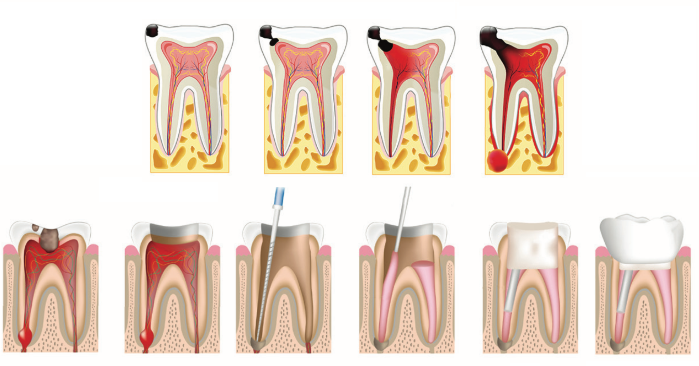
Opis specjalizacji
What is endodontics about?
Endodontics (canal treatment in other words) is about treating teeth from the inside. It is performed when caries has already reached the dental pulp, causing its irreversible inflammation and, in turn, strong toothache or osseous changes near root apexes.
Canal treatment is the treatment of last chance – it helps save the diseased tooth from extraction. For this to be possible, the tooth must be rendered dead. The dentist removes the so-called pulp (nervous and vascular tissue) from its inside and fills the tooth canal with special material precisely, preventing intrusion of bacteria. Even though the tooth after canal treatment is dead, it can still fulfil its function. It is enough to strengthen and reconstruct it properly and then check it at the dentist’s once in a while.
Endodontics requires precision. To fill tooth canals, the doctor often uses a dental microscope, which makes it easier to perform the procedure on the interior of the tooth, a very small area, precisely and carefully.
When is it worth to perform canal treatment?
- If there is chronic toothache and painkillers do not help.
- In advanced caries reaching deep into the interior of the tooth – its total removal will not be possible without damage to the pulp, which is located directly under the caries and has been irritated by cariogenic bacteria.
- If there is inflammation visible on X-ray image around tooth roots. It sometimes happens in teeth which have already been subject to canal treatment. Such an inflammation threatens the bone in which the tooth is set: proliferating bacteria may destroy it.
WHAT YOU SHOULD KNOW: Caries and inflammation around tooth roots may be asymptomatic (without pain). To prevent them, it is worth performing regular dental check-ups.
- If a tooth is broken, damaged or chipped and it cannot be reconstructed with ordinary filling. A tooth with has been subjected to canal treatment, provided with an insert of proper size, can be a basis for crown placement even if it was broken evenly along the gum line or under the gum.
- Before some prosthetic procedures, e.g. when the tooth is to be covered with a bridge where it will be the pillar tooth.
- If a tooth was subjected to canal treatment over 8 years ago – it can require another purification and sealing of canals. Thanks to modern dental techniques and materials, the currently pursued canal treatment is even more precise than several years ago.
Endodontics at enel-med
At enel-med dental offices, we offer a full range of canal treatment.
Learn about our offer:
- Full diagnostics
Most frequently, the patient goes to the endodontist with toothache. When pain indicates irreversible pulp inflammation, the dentist has to make sure whether the tooth requires canal treatment. To do this, they interview the patient and perform a periapical X-ray scan of the tooth or a panoramic radiograph.
As canal treatment results in tooth death, the decision to perform it must always be preceded by full diagnostics. The examinations will also help pinpoint the location of the inflammation – the patient cannot always specify its source.
- Canal filling
Canal treatment requires from 1 to 3 visits at the dentist’s. All depends on the tooth to be treated: its type and number for canals for filling. The number and shape of canals is a very individual matter: there are canals that are fairly easy to fill without a microscope, but there are also more complicated ones, which must be treated under microscopic magnification.
Due to the specific nature of canal treatment, an X-ray scan is necessary at its every stage.
- Treatment under microscope
In some cases, canal treatment must be performed under magnification. It happens that patients have an atypical anatomy of teeth or there are difficulties at a stage of treatment: this is where a dental microscope becomes useful.
At enel-med, we have latest generation microscopes. We also admit patients from other offices with referrals to a specialist working with a dental microscope.
What does canal treatment look like?
Stages of canal treatment
- Topical anaesthesia allowing to perform the procedure in a totally pain-free manner.
- Protection of teeth against intrusion of saliva with swabs or a cofferdam. A cofferdam is a small flexible protection covering all teeth apart from the one to be treated. It is most often used in treatment under magnification.
- Purification of the interior of the tooth and root canals off caries.
- Rinsing of canals with antiseptic agent.
- Drying and filling of tooth canals with special material.
- Check-up X-ray image.
- Reconstruction and reinforcement of the tooth: protection against chipping, cracking or breaking.
A results of pulp removal (making the tooth dead), teeth after canal treatment become more brittle and they usually become greyer. What is often recommended is to strengthen them with glass fibre inserts, metal inserts or a crown. The dentist always suggests the type of reinforcement. They may also recommend and additional consultation with the prosthetist.

Repeat canal treatment
Repeat canal treatment consists in performance of the same activities as in the initial canal treatment but with the removal of the “old material” which was applied initially. This is needed when the first procedure failed because:
- it was performed long ago, when proper materials and tools were not available;
- it was performed without dental microscope even though such a tool was needed;
- the atypical anatomy of the patient made it impossible to find some of the canals;
- the canal was not unblocked (purified) down to its apex;
- inflammation around a tooth apex or tooth apexes developed;
- the treated tooth still hurts.
Repeat canal treatment is also worth performing when we plan to whiten the tooth which has already been subject to canal treatment and the filling material makes it impossible to use the whitening gel.
Follow-up after procedure
After canal treatment or repeat canal treatment, the patient remains under care of the dentist. The doctor checks whether pain subsides and whether the change around the root apex heals well.
It is worth making an appointment every 3-6 months and perform an X-ray examination.
Other endodontic procedures
- Tooth root resection
This is a procedure performed occasionally, if there are complications after canal treatment, e.g. inflammation around a root apex. If the inflammation is not decreasing, surgical intervention will be necessary: purification of the change on the side of the bone and shortening of the root by several millimetres (it allows removal of the bacteria around it).
Tooth root resection is performed by a dental surgeon. The procedure is performed under topical anaesthesia.
- Removal of a broken tool
This is a precise procedure, most often performed with a dental microscope. It is necessary if after a previous canal treatment there is a broken part of a dental tool inside a tooth canal. Even the slightest residue blocks the canal lumen, making it impossible to purify and fill it down the very apex correctly.
Removal of the residue from the canal is very difficult. Such a tool usually has a spring-like shape, so removing it from such a narrow space requires creating access for another tool in the canal.
- Removal of posts and cores
Sometimes a tooth subjected to canal treatment around 8-10 years ago suddenly starts to ache. The pain may result from incorrect treatment, which caused the development of bacteria and inflammation over years. To avoid tooth extraction, it must be treated again. To that end, the dentist removes the crown and pulls out the insert so as to gain access to the canals. After repeat canal treatment, a new insert and crown must always be made as they cannot be removed without damaging them.
- Internal whitening
It is performed only on dead teeth (teeth subjected to canal treatment). After canal treatment, a tooth usually becomes greyer, which makes it stand out from the other teeth in terms of colour.
If canal treatment was performed correctly, with materials which are used for fillings as standard, the tooth can be whitened. Whitening entails application of whitening gel to the inside of the tooth several times, at the interval of 2-4 days. The number of gel applications depends on the effect we want to achieve – before each application, the dentist assesses its legitimacy.
Internal whitening is entirely pain-free. A cycle of whitening visits ends with the placement of permanent composite filling matching the new tooth colour.
How to prepare for the first visit?
- If you report to your dentist with pain, recall what and how much painkillers you use.
- Try to determine which tooth or teeth cause pain.
- Try to describe the type/nature of the pain and the situations when it appears. Think of any factors that exacerbate the pain.
- Prepare for possible diagnostics: panoramic radiograph, periapical X-ray image. At times, planning of treatment requires additional examinations, also small X-ray images.
- Bring your examination results – panoramic radiograph, tomography – even those made several years ago.
What are the benefits of canal treatment?
- Pain relief – even though canal treatment may take several visits, you will feel deep relief after the first one already. The dentist may prescribe you an antibiotic or a stronger anti-inflammatory drug to soothe any ailments which develop after a visit.
- Preservation of your own tooth for the years to come – even an implant will not replace your own tooth in terms of function and aesthetics. A tooth that has become dead after canal treatment is much better tolerated by the body than its implant.
- Purification of the tooth off bone-destroying bacteria – this is also a benefit for the adjacent teeth, onto which the bacteria may migrate.
- A robust base for prosthetic procedures – for prosthetic bridges and crowns to serve us several years, the teeth being their pillars must be subject to correct canal treatment.
FAQ
How to prepare for the first visit?
- If you report to your dentist with pain, recall what and how much painkillers you use.
- Try to determine which tooth or teeth cause pain.
- Try to describe the type/nature of the pain and the situations when it appears. Think of any factors that exacerbate the pain.
- Prepare for possible diagnostics: panoramic radiograph, periapical X-ray image. At times, planning of treatment requires additional examinations, also small X-ray images.
- Bring your examination results – panoramic radiograph, tomography – even those made several years ago.
What are the benefits of canal treatment?
- Pain relief – even though canal treatment may take several visits, you will feel deep relief after the first one already. The dentist may prescribe you an antibiotic or a stronger anti-inflammatory drug to soothe any ailments which develop after a visit.
- Preservation of your own tooth for the years to come – even an implant will not replace your own tooth in terms of function and aesthetics. A tooth that has become dead after canal treatment is much better tolerated by the body than its implant.
- Purification of the tooth off bone-destroying bacteria – this is also a benefit for the adjacent teeth, onto which the bacteria may migrate.
- A robust base for prosthetic procedures – for prosthetic bridges and crowns to serve us several years, the teeth being their pillars must be subject to correct canal treatment.
Contact form
Please complete the form below. We will call you back, tell you about the details of the offer and arrange an appointment for you.



